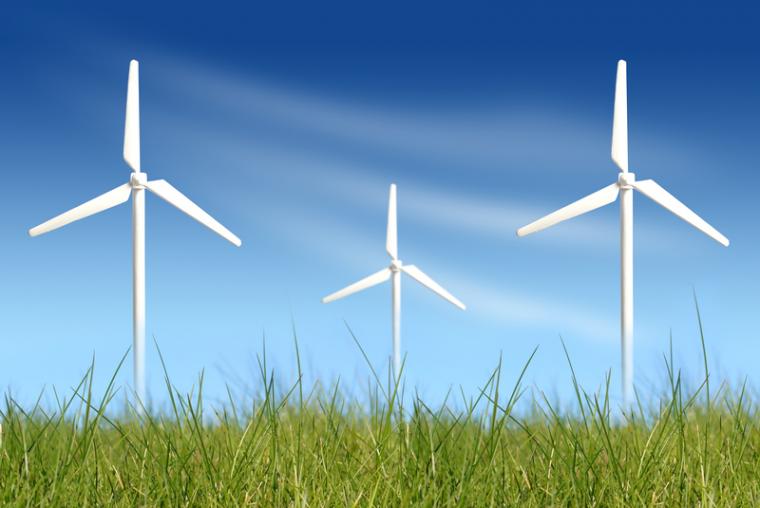
 The wind energy industry is contributing more electrons than ever to the U.S. grid. Wind power now comprises over four percent of electricity generation in the U.S., and generation records were broken in several regions in 2013 and the first part of 2014. The 905 utility-scale wind projects operating in the U.S. as of the end of 2013 are now able to power the equivalent of over 15.5 million American homes.
The wind energy industry is contributing more electrons than ever to the U.S. grid. Wind power now comprises over four percent of electricity generation in the U.S., and generation records were broken in several regions in 2013 and the first part of 2014. The 905 utility-scale wind projects operating in the U.S. as of the end of 2013 are now able to power the equivalent of over 15.5 million American homes.
But perhaps the biggest story within the wind industry for 2014 is one of ramp-up — specifically, the sheer number of megawatts (MW) that are under construction. An historic 12,000 MW and 100 projects were under construction as 2013 drew to a close, and 13,000-plus megawatts were being constructed as of April 1.
Growth in Construction and Generation
What also has become apparent is that wind energy has become the primary choice for new generation capacity in wind-rich regions. Between 2011 and 2013, wind energy delivered roughly 60 percent or more of new electric generation capacity in the Pacific Northwest, Plains states and Midwest, and as much as 80 percent in the upper Midwest. During those years, in fact, renewable energy sources were the single largest source of new energy capacity in all regions across the country outside of the Southeast and Mid-Atlantic.
Taking a look at wind energy from a national perspective, the clean and affordable energy source contributed 31 percent of all new electric generation capacity in the U.S. over the past five years, underscoring how both utilities and ratepayers are gaining a better understanding of wind’s affordability, reliability and other benefits.
Wind power’s growth is attributable to a number of factors. Among them is its affordability. The cost of wind energy dropped 43 percent between 2008 and 2012, according to the U.S. Department of Energy (DOE). That reduction comes largely from the industry’s continuing technological advances in several areas, from improved siting techniques to larger rotor diameters and taller towers, which now average 97 meters and 80.3 meters respectively, increasing energy production by accessing higher wind speeds at taller elevations. In addition, the supply chain for the 8,000 components that go into a wind turbine has been established here in the U.S., creating transportation and logistics efficiencies — and manufacturing jobs to go with them.
Wind energy is also proving its ability to integrate into the grid and contribute. Wind provided over 60 percent of the electricity on utility Xcel Energy’s Colorado system at one point last year, while several regions also broke records for wind generation at a given time. Year-round, wind energy in 2013 topped the 25 percent milestone in both Iowa and South Dakota.
 Benefits across All Regions
Benefits across All Regions
By the end of 2013, 61,110 MW of wind energy were operating in the U.S. across 46,100 wind turbines in 39 states and Puerto Rico. An average of $15 billion a year is invested in new projects, resulting in the industry posting 19.5 percent average annual growth over the past five years. The energy technology is increasingly looked upon as a job creator and a new revenue stream for rural communities via taxes for schools and hospitals as well as for farmers and ranchers, many of whom have gained a new cash crop by hosting turbines on their land while being able to simultaneously work that land.
Wind energy activity is now occurring in all 50 states, from project construction and operations to wind-related manufacturing. The 905 U.S. wind projects span 39 states while the 560 manufacturing facilities span 43 states. The majority of U.S. Congressional Districts, over 70 percent, have a wind project, a manufacturing facility or both.
Power Purchase Agreements
In another sign of the industry’s strength, last year saw a record number of power purchase agreements (PPAs) signed, as utilities continued to display ever-increasing understanding of wind power’s cost-competitiveness and ease of integration onto the U.S. grid. At least 60 PPAs for nearly 8,000 MW were signed by utilities and corporate purchasers. Notably, of those megawatts, 5,200 MW had not yet started construction as of the end of 2013, so they are “add-ons” to the feverish construction activity that started off 2014.
In 2013, as utilities inked PPAs, they regularly expressed enthusiastic support for wind energy and its benefits. The utility AEP-Public Service Co. of Oklahoma purchased nearly 600 MW of wind. And billionaire investor Warren Buffet’s MidAmerican Energy, in 2013 announced its intention to invest over $1.9 billion into wind power in Iowa, signaling to investors that American wind power is an important and growing feature of the American energy landscape.
Other signals of the industry’s strength came via news on several other fronts in 2013. Major players in the energy and tech industries showcased the power of wind as an affordable, fuel-free resource, with announcements from Facebook, Microsoft and Google, all concerning commitments to build wind-powered data centers. Non-utility entities (usually corporations) entering directly into PPAs and even investing in their own wind facilities represent a relatively new and favorable trend for the industry.
Outlook and Road Ahead
One important trend that bodes well for the industry is in the area of transmission, which is needed to link America’s world-class wind resources with demand centers. Over 10,000 MW of new transmission capacity was completed in 2013, and near-term projects could deliver another 60,000 MW of wind energy — nearly the total amount of wind energy installed today.
Meanwhile, the industry works to ensure a stable policy environment. Further extension of the federal Production Tax Credit for wind energy, the industry’s primary policy driver, represents an important policy goal during the current period when comprehensive tax reform — which is seen as a means of establishing longer-term wind energy policy — continues to be discussed but remains on the sideline in Congress for the time being.
 Wind energy’s environmental benefits also position the industry for success in the future. The American Wind Energy Association’s latest “Industry Market Report” notes that operational wind energy projects, combined with the projects under construction, will avoid 115 million tons of carbon dioxide emissions annually — more than five percent of U.S. power-sector emissions — while avoiding the consumption of over 36 billion gallons of water each year because wind turbines use virtually no water in operation.
Wind energy’s environmental benefits also position the industry for success in the future. The American Wind Energy Association’s latest “Industry Market Report” notes that operational wind energy projects, combined with the projects under construction, will avoid 115 million tons of carbon dioxide emissions annually — more than five percent of U.S. power-sector emissions — while avoiding the consumption of over 36 billion gallons of water each year because wind turbines use virtually no water in operation.
The industry continues to push ahead and eye robust growth. At the WINDPOWER 2014 Conference & Exhibition in Las Vegas in May, DOE shared preliminary findings for the first time of its Wind Vision initiative, launched last year at WINDPOWER 2013. The newly unveiled benchmarks include 10 percent wind energy on the U.S. power grid by 2020, 20 percent by 2030 and 35 percent by 2050.
That will require as much growth in the next six years as the past 40. Jose Zayas, director of the Wind and Water Power Technologies Office at DOE, said the preliminary research so far suggests the benefits to America could be impressive, to say the least: $520 billion saved for electric consumers between now and 2050, when electricity will cost three percent less than it otherwise would; 336 billion gallons of water saved by 2050 and 140,000 industry jobs by 2020 and 400,000 jobs by 2050, plus spinoff benefits.
The current draft of the Wind Vision suggests that approximately 10,000 MW a year would be deployed over the next several years, including substantial offshore wind starting to come online by the latter part of this decade, and major repowering of older projects starting by the mid-2020s.

